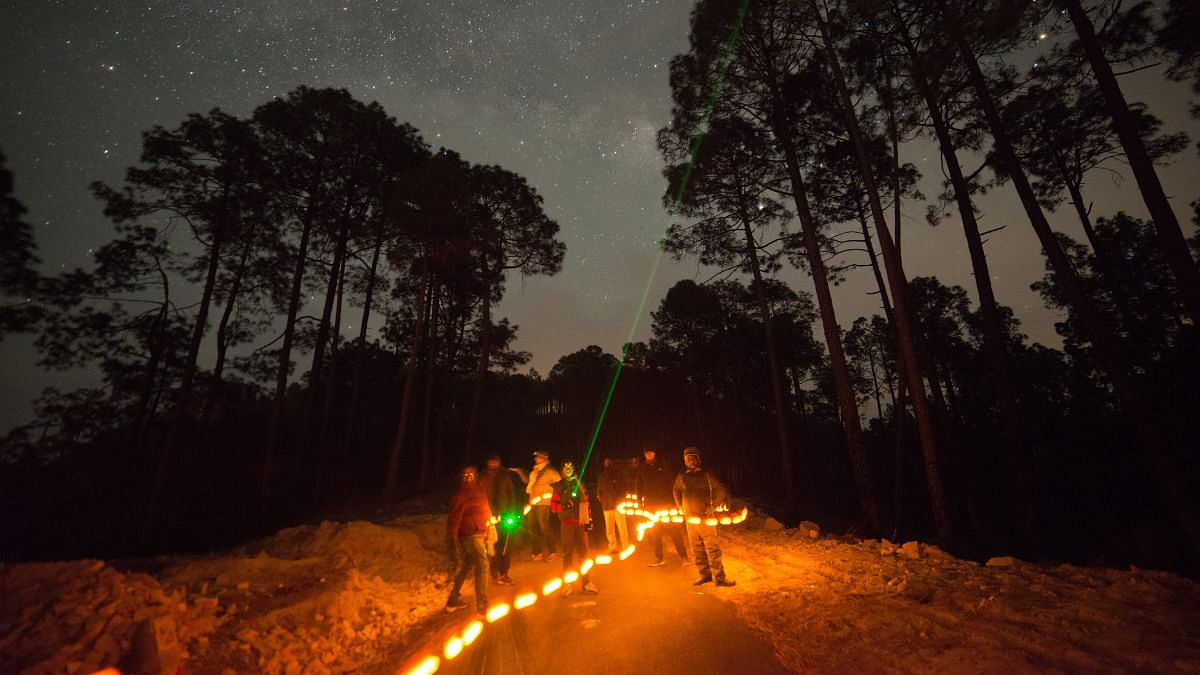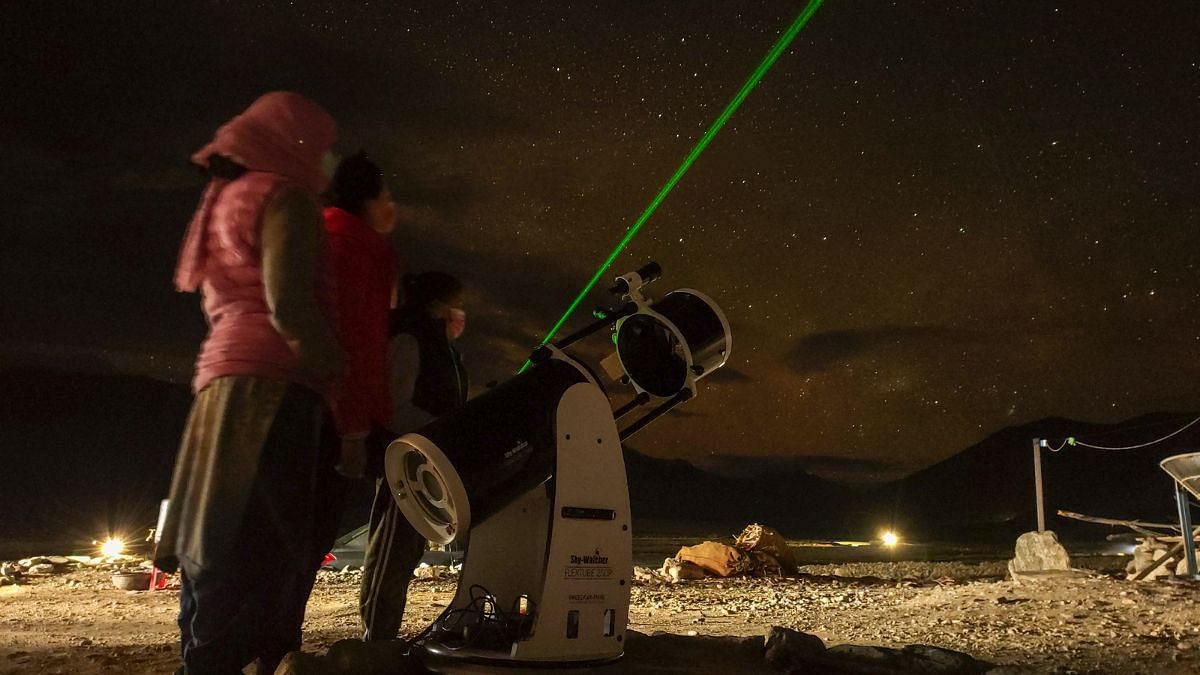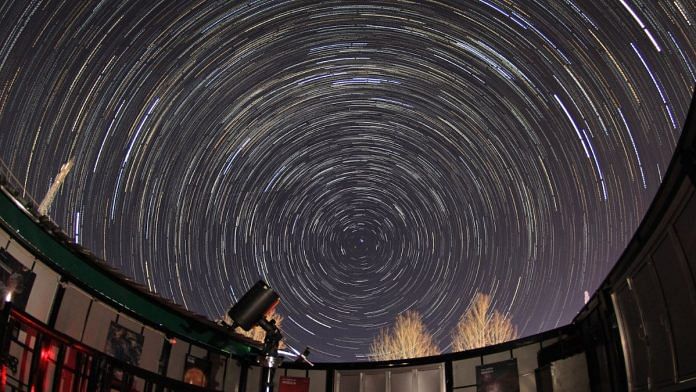Mukteshwar/Bengaluru: At dusk every day, the Starscapes observatory in Mukteshwar, Uttarakhand, comes to life. The heavy, retractable metal roof is first pulled shut to allow eyes to adjust to the darkness, and then opened, revealing the night sky in all its sudden and ethereal glory. Jupiter and its four Galilean moons, Saturn with its majestic rings, phases of Venus, surface features of the moon, the Andromeda galaxy, and distant nebulae are brought closer to home through the motorised telescope that tracks the stars.
“It was a memorable experience watching the stars and planets in the freezing cold as the guides pointed their green lasers. We could see the stars disappearing and newer ones appearing. It’s very cliché, but it really makes you realise how small you are in the universe,” said Rohit Katiyar, 39-year-old founder of a fintech startup who was visiting Mukteshwar with his friends.
Starscapes is one of the 15 or so private observatories that have sprung up in the last three to five years, catering to astrotourists—children, teenagers, young adults, parents, and grandparents who are eager to go beyond what they’ve learned from textbooks, NASA images, and YouTube explainers and actually understand the stars.
Astrotourism has taken off to become a thriving industry. Indians are now travelling to remote locations in Uttarakhand, Himachal Pradesh, Ladakh, the Andamans, and the interiors of the countryside where light pollution is minimal, all in pursuit of witnessing the mesmerising night sky. This trend is not limited to private firms; amateur astronomy groups, astrophotographers, and star-party enthusiasts are also actively participating in stargazing activities. In turn, astrotourism hotspots are witnessing a hyperlocal economic boom, with the emergence of restaurants, campsites and homestays to meet the needs of these tourists.
With large cities and skies unpolluted by lights, the Himalayan state of Uttarakhand stands out as the most popular destination for astrotourism in India. It is already home to one of India’s largest scientific observatories — Devasthal — the Aryabhatta Research Institute of Observational Sciences (ARIES) observatory. Starscapes, too, has established observatories in two other locations in Uttarakhand — Bhimtal and Kausani, along with a temporary camp in Benital.
Now, the government wants to capitalise on the interest in dark skies and develop the state into an astrotourism hub, starting with plans to market the picturesque Benital as an ‘astro village’.
“We aim to instil a deep sense of pride within the local community, and also economically empower our youth, enabling them to engage in astrotourism activities and advocate for Benital as a premier dark sky destination. The involvement of the local community in preserving the pristine nature of the place plays a big role in developing this hamlet as a dark sky location,” said Himanshu Khurana, district magistrate of Chamoli.
Other identified sites to bring up observatories include Abbott Mount, Pithoragarh, Jadung (under the Vibrant Villages programme), and Takula (in Nainital).
“What is happening here suddenly is the opposite of how it started,” said 51-year-old co-founder of Starspaces, Ramashish Ray. “In the early days, people would chance upon telescopes when they would visit the town as tourists. Today, especially since the pandemic, people are booking homestays and hotels just to visit the telescope, for which we are extremely grateful!”
But the slowly diminishing availability of dark skies and increasing light pollution can nip this nascent industry in the bud.
Also Read: Astro labs are the new wave in UP village schools. Delhi man revolutionising physics
A perfect location
At the Mukteshwar observatory, another telescope looks up at the sun during the day. Children from a Delhi school, who are camping in the wild nearby, crawl out of their tents and congregate in groups in a large clearing.
Some launch their own DIY rockets while others line up to look through Starscapes’ solar-filtered telescope at flares and spots on the sun.
As a feed from the telescope connected to a projector lights up, everyone cheers at the sight of the six or seven large sunspots and a nearly equal number of protruding solar prominences, which appeared like a flick of a paintbrush around the orange sun. Paul Savio (37), co-founder and CEO of Starscapes, is as excited as the children.
“This is the very first time I have ever seen solar prominences through a telescope,” he said.
About 2,100 m (7,500 ft) above sea level, Mukteshwar makes for a near-perfect location for stargazing — the light pollution is low, the population is small, and the night sky is spectacular against the backdrop of the endlessly cascading Himalayan ranges. Around 30 or so stairs, spread out unevenly over a path that winds through an apricot orchard peppered with wild daisies, lead to the main building. The observatory itself, which has equipment worth about Rs 6 lakh, is located on the terrace of the Starscapes building, which is seemingly perched on stilts. In the middle is the telescope and above it is the all-covering retractable roof.
At peak season, which is the month of May, and then October-November, around 4,000 tourists visit. The observatory is typically shut during snowy winters. For Rs 300 during the day and Rs 500 at night, visitors get a guided session through the telescopes, with detailed explanations.
Savio and Ray had initially set up an observatory in 2017 at Kausani as a pilot project while still working full-time in the telecom retail sector. They have since tied up with hotel and resort chains across the country: their telescopes with star guides are present at select locations of Club Mahindra resorts and at the St. Regis hotels across India.

The Mukteshwar observatory has a store below that sells astronomy and physics paraphernalia targeted at kids, such as telescopes and binoculars, NASA and ISRO spacecraft models, material for basic physics experiments, and the company’s own DIY rockets. It also hosts astro-camps where children learn to build rockets and conduct science experiments.
Savio explained that although they’ve been in the business since 2017, it was after the pandemic that interest in astronomy saw a surge.
“A big trend we and many others have observed is that, since covid, many youngsters have gone from bigger towns to their smaller hometowns—due to layoffs, new responsibilities at home, or health. So, providing a job in a company that could open doors at a national level is quite a boon,” he said.
Electrical engineer Sonal Asgotraa who established Astrostays, which organises astrotourism trips to Pangong, Ladakh, in 2019, observed a similar trend. She tied up with a veteran in Himalayan expeditions to offer stargazing combined with a scenic and serene homestay experience. While two full-time employees (and more if necessary) are on the ground as star and tour guides, the homesteaders deal with the “back-end” in terms of hospitality and bookings.
“The objective is to look at tourism from the lens of community, and integrate that community into tourism,” said Asgotraa.
Also Read: Humayun was obsessed with astronomy, wanted a utopian society favoured by heavens
Amateurs leading the way
From Chandrayaan to Gaganyaan, India’s space missions have brought the skies closer home. It’s given a much-needed shot to amateur astronomers who are banding together to organise stargazing trips, teach people to make telescopes, and introduce the curious public to this niche hobby.
Amateur astronomers are by no means amateurs, despite their title. They are deeply knowledgeable about the night sky and regularly contribute to some of the largest findings in astronomy, irrespective of professional background. They are also the biggest and most active proponents of stargazing.
In Bengaluru, the Association of Bangalore Amateur Astronomers (ABAA) has been meeting every Sunday since 1976 in a dedicated room at the Jawaharlal Nehru Planetarium in Bengaluru. Neither weather nor traffic gets in the way. During their three-hour meeting from 6-9 pm, they engage in discussions ranging from deeply scientific texts to profoundly unscientific Whatsapp forwards. This is typically followed by a star gazing session when clear skies are present.
The youngest person to attend their meetings was 10 years old, and the oldest was a 92-year-old. About 30 or so people gather regularly, with the number of guests going up to 50 or even 100 when a celestial event approaches.
In one session, a student presented their theoretical physics research in a condensed and simple form, talking about black holes for 20 minutes to an enraptured audience, a couple of whom took notes. ABAA’s members have conducted walks around the city to bust myths about eating during eclipses.
Thirty-year-old member Rohan Nagaraj, who works at a fintech startup in Bengaluru, distinctly remembers his first experience spotting a comet with ABAA in 2013.
“It was the comet ISON and I remember it because it was the first comet I saw,” he laughed. “I couldn’t believe my eyes, we were extremely excited the entire time and many of us stayed back until midnight just watching the comet.”
ABAA doesn’t stop at theoretical discussions and star parties, it also teaches people how to build their own telescopes. Ravindra Aradhya, the current president of ABAA, has been with the group since 1994 and vouches for how easy it is to make telescopes.
“We do everything from scratch, regardless of age and background,” the 50-year-old explained. “We do the grinding, polishing, and testing. We use glass and PVC pipes, with our largest expense being that of coating glass with aluminium, which has to be done in a vacuum chamber.”
The activity takes 45 hours or so and after plenty of lectures and theory, the Rs 15,000 hand-built 6-inch telescope can be taken home. Members who’ve built telescopes with ABAA include shop owners, construction workers, motor shop workers, business graduates, teachers, students of all ages, elderly retired folks, groups of women, and more.
“Since Covid, interest has grown tremendously thanks to YouTube videos. We’ve more than tripled in number, and around 30 are regulars every week,” said Aradhya of the 600-strong community, which most predominantly runs on word of mouth.
ABAA also helps its members and guests to plan astrotourism trips to the outskirts of Bengaluru, although the group does not organise any travel.
The Bangalore Astronomical Society (BAS), on the other hand, does. Founded in 2006, this amateur astronomy club not only conducts walkabouts, online webinars, and star parties in and around Bengaluru but also organises trips to other remote parts of the country.

Keerthi Kiran, a 38-year-old engineer working on autonomous driving, has been the secretary of BAS since 2012. He organised trips to Coorg, Ooty, and Andaman last year.
In Chennai, amateur astronomer, Bhavanandhi, runs Starvoirs, which organises stargazing trips across India and now to Kenya.
“One night in 2014 changed my life, I looked through the telescope for the first time when I was on a trek. I decided to dedicate my time to travelling to photograph the skies,” he said. He started off as just a guide for the night skies without any equipment until he got his first telescope. After visiting a friend’s campsite near Kota with clear skies, he moved from part-time star parties to full-time astrotourism and founded Starvoirs after quitting his job at a leading bank in 2018.
“I have about nine telescopes now, and I keep them at various locations like Rameshwaram, Chidambaram, Kodanad, Andaman, Nagaland, etc. as they’re heavy,” said Bhavanandhi.
The team regularly organises trips to various parts of India, including Andaman, averaging four to five trips a month. Currently, a small group of 15 headed by Bhavanandhi is getting ready to fly to Masai Mara, the large wildlife reserve in Kenya, for nearly a week. The cost is Rs 125,000 per person from Nairobi.
Also Read: Vikram Sarabhai, the father of Indian space programme who was also a connoisseur of arts
Not for the unhealthy
In the amateur astronomy community, there are fewer women than men, but that gap is now being slowly bridged.
Stargazing requires being out at night, which immediately increases the threat to safety for women and children. It also causes disruption to the sleep cycle. Many areas are quite remote and can be difficult or painful to access especially when coupled with harsh weather.
ABAA, for one, has set “comfortable grounds” without any discrimination.
“Women, as well as male members, support [each other] sharing rides back home and making it comfortable for women to stay back until even 10 pm on Sundays,” said Anitha Ravishankar, a postdoctoral candidate at University of Calgary, who attended ABAA meetings for ten years and credits her public speaking skills to her scientific presentations there.
Many others echo similar sentiments while acknowledging the gender gap.
“We have women of all ages, but we would really like to make their numbers at least equal to male numbers,” said Aradhya.
Accessibility is another deterrent, and this is true especially for those hoping to visit Hanle, home to one of the highest observatories in the world, Indian Astronomical Observatory (IAO). No matter one’s wealth, Hanle is not enjoyable without health.
The trip to the remote village, located at an elevation of 4500m, is a challenge, but the brave are rewarded with deep dark skies adorned with the Milky Way that have converted many a gazer into a photographer.
“Altitude sickness occurs commonly [in Hanle] resulting in headaches, dizziness, and breathlessness. Tourists need to acclimatise at Leh for a day first, and then at Hanle for another day, before they can engage in physical activity,” said Kiran. He explained that many visitors carry their own supplemental oxygen cylinders, and said he usually advises everyone to carry tablets to manage symptoms of acute mountain sickness.
“Shortness of breath can be rapid and severe in those prone to smoking, and they need to stop for at least two months before undertaking the trip. Those with diabetes and cardiac issues can have stronger symptoms, and alcohol cannot be consumed as it would lead to immediate dehydration,” he added.
Also Read: SM Chitre, stalwart astrophysicist who once shared office with Stephen Hawking, dies at 84
The Darker the sky, the better
For dedicated astrophotographers, the trek to high altitudes is worth the discomfort. But even after travelling great distances, their perfect shot is often ruined (or improved) by a streak of Starlink satellites, which are increasingly posing a problem to observational astronomy.
However, a major, unanimous concern among the astronomy community is the increasing lack of dark skies. City and outskirts skies, which were once black velvet drapes with twinkly sparkles 20 years ago, now barely show beyond the top few brightest objects.
“People think simply turning off lamps and streetlights would lead to a dark sky. But lights from large distances get scattered into the atmosphere,” said Kiran. More often than not, they have to travel several kilometres away from a city to find dark skies.
Now astronomers, both professional and amateur, are calling for setting aside large areas of land as dark sky areas.
Darkness for astronomy is measured most commonly on the Bortle scale, going from one (excellent) to nine (inner city). The loss of dark skies also causes grave problems to animals like dung beetles and newly hatched turtles that use starlight and moonlight for navigation, said Kiran.
This awareness is fuelling a movement to educate the public and advocate for policy changes to preserve dark skies and designate protected areas.
The International Dark-Sky Association (IDS) is a grassroots advocacy network for dark skies and has categorised geographical regions into four types of dark skies: sanctuaries (extremely remote, fragile, and darkest places in the world), reserves (a core dark zone surrounded by staff-inhabited periphery), parks (publicly or privately owned with minimal outdoor lighting), and communities (organised cities or towns fully compliant with proper lighting).
India has just one designated ‘dark sky place’— the Hanle Dark Sky Reserve, which was given the distinction last year. An area with a radius of about 22 km around the Indian Astronomical Observatory falls under the reserve, explained Dorje Angchuk, engineer-in-charge at the observatory and a Hanle resident.
To maintain the astronomically dark skies at Hanle, lights can only be used indoors; therefore, curtains are mandatory. All lights including street lamps should be directed towards the ground. Only warm yellow lights should be used, not white or blue, whose waves travel longer distances. Along the roads, delineators are installed for drivers; vehicle movement is restricted after a point at night; and high-beam headlights are not allowed.
Angchuk said that villagers have been made aware of these restrictions, and many have welcomed the decisions, and the steadily growing number of tourists.

Many places in the country have enough dark skies to be designated and preserved, explained Savio. Despite Madikeri, in Coorg, being so close to cities, its coffee plantations and natural forests make it a three (rural sky) on the Bortle scale. Kausani is at a convenient two (typical truly dark site), with bright views of the Milky Way band and starlight bright enough to cast shadows.
“We have seen with tiger conservation how voices can build up, so we are hoping to affect change and raise the issue of conservation of dark skies,” said Ray.
The process to develop more areas as dark sky places and develop them within the necessary lighting conditions is yet to take off in India. The three-year process would first involve officials identifying dark sky areas and then submitting a proposal for any designation. Plans for such areas should commence immediately before more and more of India becomes bathed in light, say amateur astronomers.
“When we were kids, we could step out and see hundreds of stars. Today that number has more than halved, and it is extremely sad that this source of wonder all of us could easily see is becoming increasingly invisible to us,” said Savio.
(Edited by Theres Sudeep)



